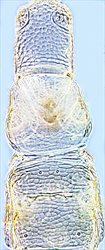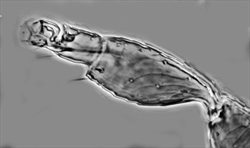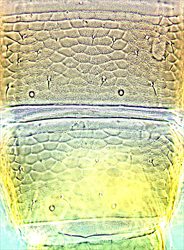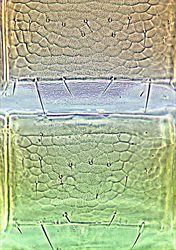
Female

Antenna

Antenna

Head & thorax

Head & pronotum

Tergites VIII-IX

One-segmented tarsus

Tergites VII-VIII

Female sternites VII-VIII

Male tergites VII-X
Both sexes without wings. Body and legs yellow, although individuals developing on halophytic plants are commonly darker; antennal segment VI shaded brown. Antennae 6-segmented; segment VI pedicilate, twice as long as V and tapering to apex; segments III–IV each with a simple sense cone. Head and pronotum without long setae; head longer than wide, ocelli not developed; maxillary palps 3-segmented. Meso- and metanota transverse. Tarsi each with only one segment. Abdominal tergites and sternites with no posteromarginal craspedum; tergal discal setae varying from 2–20; tergite IX posteromedian setae short, about 0.2 times as long as lateral pair of setae; sternites with many discal setae.
Male similar but smaller; sternites without pore plates; tergite IX with 2 pairs of stout thorn-like setae.
Four species are recognized in this European genus (Palmer, 1975; zur Strassen, 2003). These are all completely wingless, but differ in the number of segments on the antennae and tarsi, and also in details of the chaetotaxy on the tergites and sternites. A. rufus is similar to elegans in having 6-segmented antennae, but antennal segment II is more slender and narrowed to the base.
Feeding and breeding on the leaves of various species of Poaceae.
In Britain, it is both widespread and common having been recorded from Kent to the Shetland Islands, including the Outer Hebrides (Mound et al., 1976). It is also found in Northern Ireland as well as the Republic of Ireland (O'Connor, 2008). This species is found throughout the temperate regions of the world.
THRIPIDAE - THRIPINAE
Aptinothrips rufus (Haliday)
Thrips (Aptinothrips) rufus Haliday, 1836: 445
Thrips (Aptinothrips) nitidulus Haliday, 1836: 446
Aptinothrips rufa var. connaticornis Uzel, 1895: 153
Uzelliella lubbocki Bagnall, 1908: 5
Aptinothrips intermedius Priesner, 1920: 52
Aptinothrips groenlandica Richter, 1928: 850
Mound LA, Morison GD, Pitkin BR & Palmer JM (1976) Thysanoptera. Handbooks for the Identification of British Insects 1 (11): 1–79.
O’Connor JP (2008) A review of the Irish thrips (Thysanoptera). Irish Naturalists’ Journal 29: 20–24.
Palmer JM (1975) The grass-living genus Aptinothrips Haliday (Thysanoptera: Thripidae). Journal of Entomology (B) 44 (2): 175–188.
zur Strassen R (2003) Die terebranten Thysanopteren Europas und des Mittelmeer-Gebietes. Die Tierwelt Deutschlands 74: 1–271.